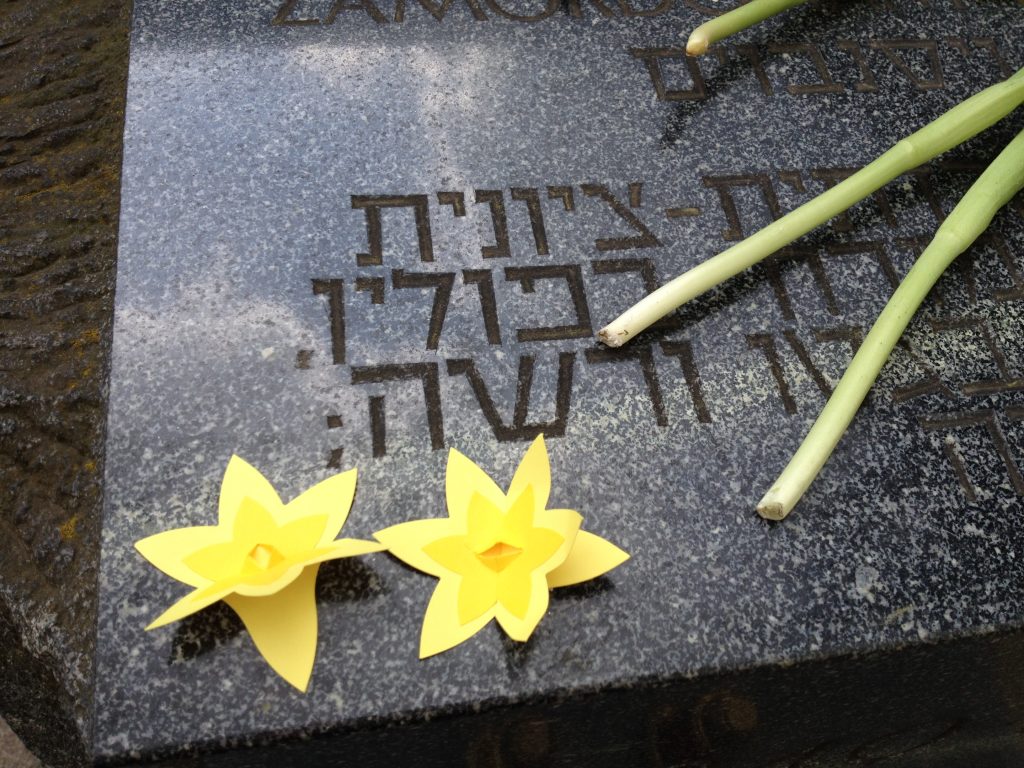Daffodils are “kick[ing] me in the eye[1]” at every turn. Along with their ubiquitous literalness in Warsaw’s April, the daffodil has cropped up as a wholly surprising (to me) cultural symbol this month. To commemorate the 71st anniversary of the Jewish Ghetto Uprising on April 19th, the daffodil was invoked to transform the yellow badge Jews were required to wear during the Nazi occupation into a symbol to “express your respect and memory of the heroes from the Warsaw Ghetto.” The Museum of the History of Polish Jews and its partners handed out thousands of “daffodil pins,” which when worn assumed the look of the yellow patch. As I walked around town, I encountered people on the street, in the mall, and queuing at the grocery store wearing yellow patches turned daffodils to commemorate “a common heritage” and in solidarity with those who had been forced to wear the patch. I wore my own. The overall effect was confusing-distressing-confusing.
Heretofore, my own tenors for daffodil as metaphor had been provided by Wordsworth’s 1888 poem, “I Wandered Lonely as a Cloud,” and the 20th century postcolonial critique it catalyzed. Poet Lorna Goodison, who can quote more by heart than I thought humanly possible, walked into my graduate seminar one April with, “And then my heart with pleasure fills, / And dances with the daffodils.” She intended an irony that Wordsworth did not and added to his lines something about how being educated in the British system in Jamaica, meant learning to traffic in metaphors with no locally meaningful tenors. Daffodils are not native to Jamaica, nor to many other places, but they spread across the globe one way or another courtesy of the British Empire. School children everywhere were expected to relate, whether or not this was a flower they’d ever seen. Many besides Goodison have noted the problematic including West Indian writer, Jamaica Kincaid, Guyanese poet, Grace Nichols, and a slew of critics. For these poets and writers, the daffodil’s tenor is tied to colonial legacy, gender, and power.
Not surprisingly, Wordsworth’s legacy was wholly absent from the tenor of the daffodils I encountered on this April 19th . According to the literature that accompanied the daffodil pins at the museum, “daffodils are associated with Marek Edelman, the last commander of the Jewish Combat Organization.” On the anniversary of the uprising each year, he placed daffodils on monuments and sites associated with the extermination of Jews. Many followed in his footsteps this year, and the monuments throughout my neighborhood—I live in Muranów, the neighborhood built in the 1950s on the remains of the Ghetto—were covered with daffodils. As far as I can tell, however, the daffodil as yellow patch is a new twist, and it represents a different kind of maneuver. Whereas the ritual of leaving flowers on the historic sites re-invokes an historical performance, the daffodil pins do something else. Via paper cut and assembled to resemble both daffodil and Star of David, and the performance that resulted when the public donned the pins, the daffodil was invoked as a transformative symbol rather than a ritual prop.
What was so confusing-distressing-confusing to me was that the maneuver failed to be transformative. The horror I experienced seeing people wearing the pin-patch did not abate no matter how many hours I walked through Warsaw nor how many I saw wearing it. My own pin-patch grew no less uncomfortable no matter how long I wore it nor how many people I found myself in solidarity with. The atrocities that occurred in my neighborhood do not soften with flowers or years. They do not transform. Instead, they remain starkly co-present with my everyday experience here in ways I have never before experienced. They remain raw and resistant to the work of metaphor. Whereas the daffodil yielded to the metaphoric weight Wordsworth attached to it in his poem and that Caribbean writers and scholars have in turn attached, in Warsaw on April 19th, the task was too great.
Caribbean writers and critics for whom Wordsworth’s daffodils did not resonate as intended found a means to appropriate the symbol for their own purposes. I suspect this was the intended maneuver of those who designed the daffodil pins. Perhaps it worked for others. I am neither Polish nor Jewish, and perhaps I lack the required cultural contexts to receive this symbol as transformative. Whatever the reason, the metaphor refused to do the work requested of it. I did not see daffodils on anyone’s lapels. I saw Judenstern kicking me in the eye. And, though respect and commemoration were called for by the occasion, it was difficult to feel anything beyond fear.
[1] From Guyanese poet Grace Nichols’ “Spring.”

